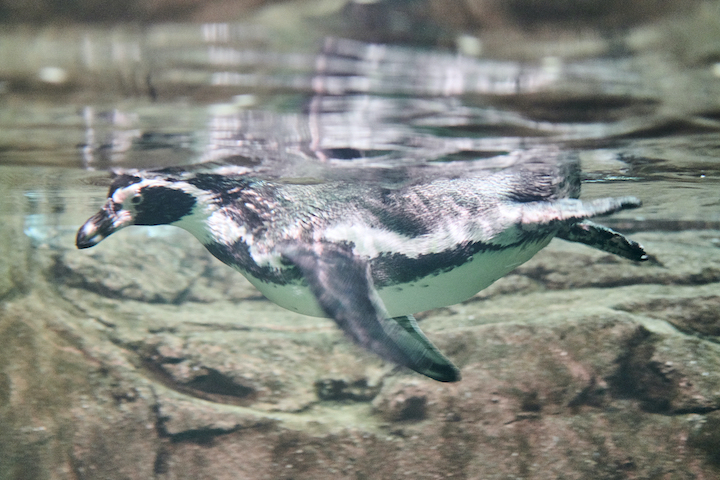Featured News - Current News - Archived News - News Categories
By Alice Gerard
Senior Contributing Writer
Grand Island’s undeveloped land provides a home to a wide variety of wildlife, said Michelle Lockett, who has been coordinating events for the Grand Island Nature Alliance, a group formed a year ago.
Lockett described the Grand Island Nature Alliance as “a group of citizens who were interested in our natural assets on Grand Island. We want to provide educational experiences and outdoor recreational experiences to our community members, along with educational talks and walks about our environment, why it’s so important and why we want to protect it, with the ultimate goal of spreading awareness of our community and why people should be proud of it and appreciate it and protect it.”
Lockett said the group intends to hold monthly events, focused on Grand Island’s environment. Its most recent event, titled “a Conservation Conversation,” was held April 10 at the Grand Island Memorial Library. Approximately 40 persons attended the event, which featured five speakers, who discussed aspects of Grand Island’s environment, ranging from identifying land that needs to be protected to providing “educational experiences and outdoor recreational experiences to our community members.”
“We are surrounded by the Niagara River,” Lockett said. “The Niagara River is actually a part of the Important Bird Area. It’s also a RAMSAR-designated wetland area, which is globally significant and fully recognized as an important area for wildlife to inhabit.”
The Birds on the Niagara website describes the Niagara River as “a dramatic and unique place known for its tremendous biodiversity(, it) is habitat for numerous species of native vegetation, fish, insects, mammals, amphibians, reptiles, and birds of global significance. This includes arctic and neotropical birds that use this corridor as a hemispheric resource during all season migrations.”
Migratory birds observed on Grand Island include ospreys, great blue herons, hooded mergansers, and great egrets. They can be seen in and around Grand Island’s creeks and marshes at various times of year.

Image courtesy of the Grand Island Nature Alliance
••••••••
At the “Conservation Conversation,” Sarah Costlow, land protection director at the Western New York Land Conservancy, talked about making sure the Island maintains habitat for migratory birds and other animals, fish and amphibians. Lockett explained the Land Conservancy is working to identify “parcels and areas that are prioritized, based on their environmental characteristics and importance. There are some areas that are depicted to be good wildway movement areas, based on the animals that they’ve identified. They’ve also identified places that are climate resilient.”
Lockett said, “Climate resilient means the makeup of the land and the water and the area around it is in a format that is going to bounce back from any major natural weather events. So, if we have a big storm, flooding, or if there’s a drought, those particular spots are going to be more likely to bounce back.”
The presentation by Diane Evans, a member of the town’s Conservation Advisory Board, focused on the town’s open space index and how the board “went about doing that and prioritizing all the parcels. She also talked about the plans to do a natural resources inventory, which will lead into an open space plan,” Locket explained. She described the open space plan as “a larger strategic plan for the Island to know what spaces they want to protect and not develop on.”
Land that has been protected includes parcels that the Western New York Land Conservancy has purchased. These parcels include the Love Road Preserve, the Margery Gallogly Nature Sanctuary, the Funk Preserve, Bush Road Woods, Gun Creek Woods, and the Alt Preserve. Total acreage of these seven properties, according to Costlow, is 275. She said the Conservancy is in the process of protecting two more properties, involving another 100 acres.
Costlow’s presentation included explaining some of the studies the Conservancy has done, including how land parcels are prioritized. During the “Conservation Conversation,” Costlow showed a map of the Island and “the parcels that, to their criteria, they see has high, medium, and low priorities to protect. They generally do conservation easements; they look for properties that are 25 acres or more. But Grand Island is a different area. We don’t have that many,” Lockett explained.
On Grand Island, the Conservancy is “looking at parcels that are 10 acres and maybe even less, and what’s near it, if there’s green space next to it, they might extend the acreage that they consider,” Lockett said.
She added, “We were hoping for people who had a lot of land that they would be interested in conserving (to come to the ‘Conservation Conversation’) so they could get connected with the Land Conservancy so they could learn more about it. I don’t think we had many, if any, people with that. So, this article, I’m hoping, will find some of them.”
Part of the “Conservation Conversation” also focuses on what Islanders see as positive features of the community.
Robbyn Drake, owner of Robbyn Drake Consulting, led a dialogue about the things that keep people on Grand Island. These include “the small neighborhood feel, peace and quiet, places to kayak, opportunities for bicycling, the nearby beaches, the location and the general larger area, that it’s pretty, you can go cross country skiing” Lockett related.
Dave Reilly and Nicole Gerber, the owners of the Alt Preserve, spoke about their experiences at the “Conservation Conversation.”
“They have a conservation easement through the Land Conservancy,” Lockett said. “They still own the property, and they still have to pay taxes on it. But the easement will protect it forever. They have a nature preserve now, too. They’re going to be putting a bluebird trail in. The renovated one-room schoolhouse is now a nature center that is open to the public. Open houses have been held during the town’s Garden Walk, as well as events held in September to celebrate local history.”
The Western New York Land Conservancy’s most recent nature preserve is land off Love Road and headed toward West River. It is 44 acres that was previously owned by the Buffalo Ornithological Society.
Trails in the preserve are “just about done,” Lockett said, noting the Conservancy is working with the town to put a culvert in, to create an access point off Love Road. Plans are to have this preserve open to the public, possibly by this fall.
Upcoming events planned by the Grand Island Nature Alliance include:
•A foraging hike at Scenic Woods, located off of Sturbridge Drive, at 5 p.m. April 24. The hike will be led by Ellen Owens. Registration is required.
•A native plant sale at the Nike Base from 5-6:30 p.m. May 10. A presentation on native plants will be offered by Reilly and Gerber. Plants from CW Plant Farm, Amanda’s Native Garden, and North Tonawanda Botanical Garden will be available for purchase. Registration is required for this event.
•“Explore the world of purple martins” will be presented at 1 p.m. June 10 and 17, and at 4:30 p.m. June 14. Each event will take place at the Beaver Island Marsh. Lockett explained purple martins live in manmade structures, such as boxes or gourds, which she described as being the “traditional manmade home for purple martins.” The DEC, she said, checks on the birds’ nests. “The DEC has been kind enough to allow some of us to come watch. They recommended when would be a good time for us to come see babies or, at least, eggs, in these nests.” Registration is required for this event.
To register for Grand Island Nature Alliance events, go to https://gi-naturealliance.org/events/.
Future events, which are currently in the planning stages, include a tree identification hike at the Nike Base, led by Parks Department employee Joe Killian; and kayak ecotours, led by Paul Leuchner. Lockett explained, “The site has yet to be determined. Probably around East River Marsh. So, (Leuchner will) probably talk about the history of the shoreline there, as well as about all of the rehabilitation work that’s been done, as well as the islands and the wildlife. Maybe also the Beaver Island lagoon. We could look at osprey nests.”

Image courtesy of the Grand Island Nature Alliance
Click HERE to enlarge (PDF)
••••••••
Endangered and threatened species found on Grand Island and offshore
Information provided by Robbyn Drake, owner of Robbyn Drake Consulting, Ecos Cooperative Inc.
●25 of these bird species are listed in New York state, including three listed as endangered (Black Tern, Short-eared Owl, Peregrine Falcon), eight listed as threatened (Pied-billed Grebe, Upland Sandpiper, Red Knot, Common Tern, Least Bittern, Northern Harrier, Bald Eagle, Sedge Wren), and 14 listed as special concern (Common Loon, American Bittern, Osprey, Sharp-shinned Hawk, Cooper’s Hawk, Red-shouldered Hawk, Common Nighthawk, Whip-poor-will, Red-headed Woodpecker, Horned Lark, Grasshopper Sparrow, Vesper Sparrow, Golden-winged Warbler, Cerulean Warbler).
●25 of these bird species are identified as high priority Species of Greatest Conservation Need (SGCN) by the 2015 New York State Wildlife Action Plan (American Black Duck, Common Nighthawk, Whip-poor-will, Upland Sandpiper, Whimbrel, Red Knot, Semipalmated Sandpiper, Little Gull, Black Tern, Short-eared Owl, Red-headed Woodpecker, Horned Lark, Olive-sided Flycatcher, Sedge Wren, Brown Thrasher, Grasshopper Sparrow, Vesper Sparrow, Bobolink, Eastern Meadowlark, Rusty Blackbird, Golden-winged Warbler, Prothonotary Warbler, Cape May Warbler, Bay-breasted Warbler, Canada Warbler). Forty-five are identified as SGCN (Blue-winged Teal, Northern Pintail, Greater Scaup, Lesser Scaup, Common Eider, Harlequin Duck, Surf Scoter, White-winged Scoter, Black Scoter, Long-tailed Duck, Common Goldeneye, Ruddy Duck, Pied-billed Grebe, Horned Grebe, Black-billed Cuckoo, Black-bellied Plover, Ruddy Turnstone, Purple Sandpiper, American Woodcock, Greater Yellowlegs, Willet, Bonaparte’s Gull, Laughing Gull, Caspian Tern, Common Tern, Forster’s Tern, Common Loon, American Bittern, Least Bittern, Great Egret, Snowy Egret, Little Blue Heron, Black-crowned Night Heron, Northern Harrier, Bald Eagle, Red-shouldered Hawk, American Kestrel, Peregrine Falcon, Wood Thrush, Louisiana Waterthrush, Blue-winged Warbler, Cerulean Warbler, Black-throated Blue Warbler, Prairie Warbler, Scarlet Tanager).
●There are at least 21 species of reptiles and amphibians likely to occur on Grand Island according to the NYS Herp Atlas. This includes one NYS threatened species (Blanding’s Turtle) and two NYS special concern species (Jefferson Salamander and Blue-spotted Salamander). Two of these species are considered high priority SGCN according to the NYS Wildlife Action Plan (Blue-spotted Salamander and Blanding’s Turtle), and four species are considered SGCN (Common Mudpuppy, Western Chorus Frog, Common Map Turtle and Common Snapping Turtle). Many of the 21 species likely occur on the property to be protected, including Jefferson Salamander and Blue-spotted Salamander. Northern Leopard Frogs also occur on Grand Island, in vernal pools and wet ATV tire ruts.
The Lower Niagara River also supports over 60 species of fish and is a valued fishing spot for anglers and fly fishers from across the region. Species include lake trout, brown trout, smallmouth bass, largemouth bass, muskellunge, yellow perch, smelt, as well as lake sturgeon, which are considered threatened.





























